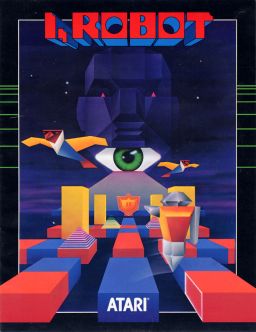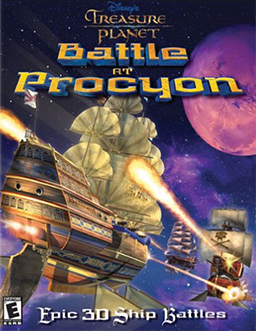
Radiant Silvergun is a shoot 'em up video game developed and published by Treasure. It was originally released in Japanese arcades in 1998 and subsequently ported to the Sega Saturn later that year. The story follows a team of fighter pilots in the far future who are battling waves of enemies summoned by a mysterious crystal dug up from the Earth. The player hosts an arsenal of six different types of shots to choose from, and a sword to destroy nearby targets. The stages are tightly designed to present players with scenarios that can be approached differently with the various weapon types.

Spy Hunter is a vehicular combat game developed by Bally Midway and released for arcades in 1983. The game draws inspiration from the James Bond films and was originally supposed to carry the James Bond brand. The object of the game is to drive down roads in the technologically advanced "Interceptor" car and destroy various enemy vehicles with a variety of onboard weapons. Spy Hunter was produced in both sit-down and standard upright versions with the latter being more common. The game's controls consist of a steering wheel in the form of a futuristic aircraft-style yoke with several special-purpose buttons, a two-position stick shift, and a pedal used for acceleration.

Robotron: 2084 is a multidirectional shooter developed by Eugene Jarvis and Larry DeMar of Vid Kidz and released in arcades by Williams Electronics in 1982. The game is set in the year 2084 in a fictional world where robots have turned against humans in a cybernetic revolt. The aim is to defeat endless waves of robots, rescue surviving humans, and earn as many points as possible.

I, Robot is an arcade shooter game developed and released in 1984 by Atari, Inc. Designed by Dave Theurer, only a total of 750–1000 arcade cabinets were produced. The arcade machine comes with two games. The first is I, Robot, a multi-directional shooter that has the player assume the role of "Unhappy Interface Robot #1984", a servant bot that rebels against Big Brother. The object of the game involves the servant bot going through 126 levels, turning red squares to blue to destroy Big Brother's shield and eye. The player can switch to the second game, Doodle City, a drawing tool that lasts for three minutes.

MoonBase Commander is a strategy video game released in 2002 by Humongous Entertainment. In the game, the player controls a main hub, which can send out other hubs, attack enemy structures, create defensive buildings, and collect energy for further expansion; this is accomplished through launching buildings and/or weapons from a hub. Each building is connected to its parent hub by a cord, which cannot overlap with other cords. The game features both single-player and multiplayer formats. It won the "Best of 2002: The Game No One Played" award from IGN.

Rampage is a 1986 arcade video game by Bally Midway. Inspired by monster films, players control a trio of monsters: George, Lizzie, and Ralph, humans transformed into creatures due to various experimental mishaps. The objective is to destroy cities and combat military forces while maintaining their health. The game is set across 128 days in cities throughout North America, with each cycle repeating five times. Gameplay includes destroying buildings, eating humans, and avoiding damage.

Tyrian is a vertically scrolling shooter developed by Eclipse Software for MS-DOS and published in 1995 by Epic MegaGames. Tyrian was programmed by Jason Emery, illustrated by Daniel Cook, and its music composed by Alexander Brandon and Andras Molnar. The game was re-released as freeware in 2004. A free and open-source port of the game started in April 2007.
Michael Jackson's Moonwalker is the name of several video games based on the 1988 Michael Jackson film Moonwalker. Sega developed two beat 'em ups, released in 1990; one released in arcades and another released for the Sega Genesis and Master System consoles. U.S. Gold also published various games for home computers the same year. Each of the games' plots loosely follows the "Smooth Criminal" segment of the film, in which Jackson rescues kidnapped children from the evil Mr. Big, and incorporates synthesized versions of some of the musician's songs. Following Moonwalker, Jackson collaborated with Sega on several other video games.

Raptor: Call of the Shadows is a vertically scrolling shooter developed by Cygnus Studios and published by Apogee Software. Its working title was "Mercenary 2029". It was released on April 1, 1994 for MS-DOS compatible systems. The first episode of the game, "Bravo Sector", was distributed as shareware, while the other two episodes were sold commercially.

RoadBlasters is a vehicular combat game released in arcades by Atari Games in 1987. The player navigates an armed sports car through 50 different rally races, getting to the finish line before running out of fuel. Ports were released for a variety of home systems by Tengen and U.S. Gold.
Blaster is a first-person rail shooter released as an arcade video game by Williams Electronics in 1983. It was developed by Eugene Jarvis and Larry DeMar. A vague sequel to Robotron: 2084, the game is a shoot 'em up set in outer space. The goal is to destroy enemies, avoid obstacles, and rescue astronauts in twenty levels, to reach paradise.

Xybots is a 1987 third-person shooter arcade game by Atari Games. In Xybots, up to two players control "Major Rock Hardy" and "Captain Ace Gunn", who must travel through a 3D maze and fight against a series of robots known as the Xybots whose mission is to destroy all mankind. The game features a split screen display showing the gameplay on the bottom half of the screen and information on player status and the current level on the top half. Designed by Ed Logg, it was originally conceived as a sequel to his previous title, Gauntlet. The game was well received, with reviewers lauding the game's various features, particularly the cooperative multiplayer aspect. Despite this, it was met with limited financial success, which has been attributed to its unique control scheme that involves rotating the joystick to turn the player character.

Fort Apocalypse is a multidirectional scrolling shooter for Atari 8-bit computers created by Steve Hales and published by Synapse Software in 1982. Joe Vierra ported it to the Commodore 64 the same year. The player navigates an underground prison in a helicopter, destroying or avoiding enemies and rescuing prisoners. A contemporary of Choplifter, it has similarities to that game as well as the arcade games Scramble and Super Cobra.

Mr. Robot and His Robot Factory is a platform game created for Atari 8-bit computers by Ron Rosen and published in 1983 by Datamost. The music was composed by Gary Gilbertson using Philip Price's Advanced Music Processor, while the title screen was drawn by Art Huff. It was ported to the Apple II by Robert McNally and to the Commodore 64.

Escape from the Planet of the Robot Monsters is a multidirectional shooter released in arcades by Atari Games in 1989. The game is styled after campy science fiction B movies of the 1950s. It was ported to the Amiga, Amstrad CPC, Atari ST, Commodore 64, MS-DOS, SAM Coupé, and ZX Spectrum.

Treasure Planet: Battle at Procyon is a real-time strategy video game, part of Disney's Action Game strand, which includes epic 3D ship battles. The game takes place five years after the events of the film, Treasure Planet. The single-player campaign details the story of Jim Hawkins ascending the ranks as a naval officer, and an additional skirmish mode includes several historical and open-map skirmishes.

Zero-K is a free multi-platform open source real-time strategy video game. Initially based on content from Total Annihilation on the open source Spring Engine, it was forked and all proprietary content replaced, and evolved into a completely new game with unique features. Among the games powered by the Spring Engine, Zero-K makes extensive use of Lua scripting for interface and gameplay changes/enhancements, as well as unique real-time strategy concepts such as a flat technology tree.

Crazy Drake is a platform game released for MS-DOS in 1996. The protagonist of the game is a duck named Prince Drake, whose mission is to rescue a golden egg from Dr. Foulbrain, an evil scientist.

Gunblade NY is a light gun rail shooter developed by Sega for the Model 2 arcade machine and was released in 1995 in North America and 1996 in Japan. The game was re-released alongside its sequel, L.A. Machineguns: Rage of the Machines for the Wii in 2010 as part of the Sega Arcade Hits Pack.

Gun Beat is an unreleased action-racing video game previously under development by Treasure for the Sega NAOMI arcade platform. The game was revealed in February 1999 at an arcade trade show in Japan alongside several other games to promote Sega's new arcade board. Gun Beat was not playable, but a gameplay video was on display. The demo reel was well received by critics who felt the game carried the same quirky characteristics and quality artwork of previous Treasure offerings. Development on the game was ceased indefinitely in May 2000 with little explanation.



















